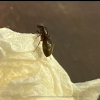I thinking of making plaster nests and I don't know which plaster too buy. Also any links will be helpful. Thanks.
- Formiculture.com
- Forums
- Gallery
- Members
- Member Map
- Chat

I thinking of making plaster nests and I don't know which plaster too buy. Also any links will be helpful. Thanks.
Generally just avoid Plaster of Paris and sanded grout. Plaster of Paris is very susceptible to mold growth and is very soft, meaning ants can chew through it easily. Sanded grout's issue is that it is terrible at absorbing water, which is not ideal for gypsum nests.
I like leafcutter ants. Watch The Ultimate Guide to Fungus Growing Ants:
https://youtu.be/VBH...4GkxujxMETFPt8U
This video took like over 100 hours of work, you should for sure watch it.
I use unsanded bathroom tile grout (available in many designer colours at your local hardware store) mixed 50/50 by volume with small particle vermiculite. Vermiculite absorbs water which helps the grout absorb water as well. I haven't seen any signs of chewing by ants at this point. I think you could probably add peat moss or finely chopped sphagnum moss, both will help with water absorption. Adding these types of materials to the grout probably makes soft spots that some determined species will manage to chew, but I've never seen it.
Edited by AntsUtah, November 21 2021 - 6:40 PM.
Leave the Road, take the Trails - Pythagoras
Utah Ant Keeping --- Here
DIY Formicariums and Outworlds --- Here
Honeypot Ant Journal --- Here
Photo Album --- Here
Videos --- Here
Being new here, I'm not sure of the protocols for this type of thing, but can I make a non-plaster suggestion? I've read that many species like to live in rotting wood, so I've used wood chips as a substrate for some of my formicariums that worked out well for Lasius niger, tetramorium, and brachymyrmex depilis. I'm presently working on a couple that I think will be readily accepted by myrmex rubra, Camponotus, and crematogaster too. The chips I use are hardwood (ash) chips that are about one year old. They are decomposing and range from small rotten pieces up to large intact pieces. As I loosely fill the space for the nest I use the small stuff in a layer, firm it and make depressions which I cover with a larger piece leaving a space underneath. I continue filling loosely making these spaces all the way along until I reach the top. A little topsoil and moss, a rock or two and it's ready for occupants. My ants have widened out the chambers as needed and connected them together. There are many other steps in the construction process that I have not mentioned here such as ventilation, water, etc but you get the idea. I pick any clear container and put something in the center to restrict the ants to the outside. A layer of cotton or sponge on the bottom for hydration, a little soil for good contact with the chips and start filling. I usually finish off with a little topsoil and moss. I use living moss that I collect growing on wood. and it can also be used to gauge the moisture in the substrate below. If the moss is dry the chips are too dry. I can spray it to water the nest from the top down without flooding. I also use moss and succulents in my outworlds to create a "wet hole" in one corner. I like to do this because I think it makes the outworld look more real and adds interest for me and the ants. Sure, a niger queen will occasionally live in the moss or they'll raise larvae in there, so what. If they're busy, making tunnels and poking around in the moss they're not trying to escape! Maybe plaster nests are just too easy and boring for ants --- nothing to do so let's find a way out of here. A wood chip formicarium has many advantages for the ant keeper, but most of all the ants like it and it gives them something to do. A busy ant is a happy ant.
Thank you all for replying!
0 members, 0 guests, 0 anonymous users